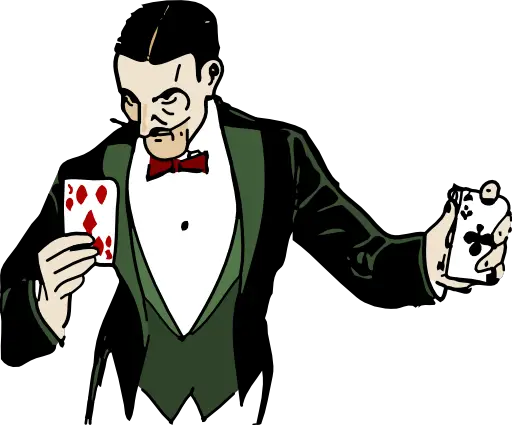Support our educational content for free when you purchase through links on our site. Learn more
[2023] Verbal Mind Tricks: Master the Art of Psychological Manipulation
Table of Contents
- Quick Answer
- Quick Tips and Facts
- What Are Mind Tricks?
- The Power of Verbal Mind Tricks
- How to Play with People's Minds
- The Easiest Psychological Trick You Can Play on Someone
- Mastering the Mentalist Trick
- Common Mind Tricks and How to Use Them
- FAQ
- Conclusion
- Recommended Links
- Reference Links
Quick Answer
Verbal mind tricks are powerful psychological techniques that allow you to manipulate and influence others through the power of words. By understanding how the mind works and employing various techniques such as misdirection, suggestion, and the anchoring effect, you can effectively play with people's minds and create fascinating experiences. Mastering the art of verbal mind tricks requires practice, creativity, and a deep understanding of human psychology.
Key Answer: Verbal mind tricks are powerful psychological techniques that allow you to manipulate and influence others through the power of words. By understanding how the mind works and employing various techniques such as misdirection, suggestion, and the anchoring effect, you can effectively play with people's minds and create fascinating experiences.
Quick Tips and Facts
- Verbal mind tricks leverage psychological principles to influence and manipulate others.
- These techniques can be used for entertainment, persuasion, or personal growth.
- Practice, creativity, and a deep understanding of human psychology are key to mastering verbal mind tricks.
- Verbal mind tricks can be learned and applied by anyone with dedication and practice.
- Ethical considerations should be taken into account when using verbal mind tricks.
Now, let's dive deeper into the world of verbal mind tricks and explore how you can master this fascinating art.
What Are Mind Tricks?
Before we delve into the intricacies of verbal mind tricks, let's first define what mind tricks are. Mind tricks, also known as psychological tricks or mentalism techniques, are methods used to manipulate and influence the thoughts, perceptions, and behaviors of others. They rely on exploiting cognitive biases, perception, and the power of suggestion to create illusions and captivate audiences.
While mind tricks are often associated with magic and entertainment, they have practical applications in various fields such as sales, negotiation, therapy, and personal development. Verbal mind tricks, in particular, utilize the power of language and communication to create profound psychological effects.
The Power of Verbal Mind Tricks
Verbal mind tricks harness the power of language to influence and manipulate others. They are based on the understanding that our minds are susceptible to certain cognitive biases and patterns of thinking. By strategically utilizing specific words, phrases, and techniques, you can guide someone's thoughts, perceptions, and behaviors in a desired direction.
The effectiveness of verbal mind tricks lies in their ability to tap into the subconscious mind and bypass the conscious rational thinking process. They create a sense of intrigue, fascination, and even confusion, which opens the door for suggestion and manipulation. When executed skillfully, verbal mind tricks can leave a lasting impression and create memorable experiences for both the performer and the audience.
How to Play with People's Minds
Playing with people's minds requires a combination of knowledge, practice, and creativity. Here are some key steps to effectively play with people's minds using verbal mind tricks:
-
Understand Human Psychology: Familiarize yourself with the principles of human psychology, cognitive biases, and the power of suggestion. This knowledge will provide a solid foundation for crafting and executing mind tricks.
-
Master Nonverbal Communication: Nonverbal cues such as body language, facial expressions, and tone of voice play a crucial role in delivering mind tricks effectively. Practice and refine your nonverbal communication skills to enhance the impact of your verbal mind tricks.
-
Choose the Right Technique: There are various techniques you can employ to play with people's minds. Some common techniques include misdirection, suggestion, anchoring, framing, and social compliance. Choose the technique that best suits your desired outcome and practice it until it becomes second nature.
-
Practice, Practice, Practice: Like any skill, mastering verbal mind tricks requires practice. Rehearse your tricks, experiment with different approaches, and seek feedback from others to refine your performance.
-
Be Ethical: While mind tricks can be entertaining and fascinating, it's important to use them ethically and responsibly. Always consider the well-being and consent of your audience, and never use mind tricks to deceive or harm others.
Remember, the true essence of verbal mind tricks lies in creating wonder, fascination, and entertainment for others. Use your skills responsibly and always respect the boundaries of those you interact with.
The Easiest Psychological Trick You Can Play on Someone
If you're new to verbal mind tricks and want to start with something simple yet effective, the "Forer Effect" is a great technique to begin with. The Forer Effect, also known as the Barnum Effect, refers to the tendency of individuals to believe vague and general personality descriptions as highly accurate and specific to them.
To play this trick on someone, follow these steps:
-
Gather a Group: Ideally, gather a small group of people to maximize the impact of the trick.
-
Prepare Personality Descriptions: Write down a series of vague and general personality descriptions that could apply to almost anyone. For example, "You have a strong desire for success, but sometimes feel insecure about your abilities."
-
Present the Descriptions: Distribute the personality descriptions to each person in the group, ensuring that they believe the descriptions are unique to them.
-
Reveal the Trick: After everyone has read their descriptions, reveal that the descriptions were actually the same for everyone. Explain the Forer Effect and how it demonstrates the power of suggestion and our tendency to seek validation in vague statements.
This simple trick can create a sense of astonishment and make people question their own perceptions. It's a great way to introduce others to the fascinating world of verbal mind tricks.
Mastering the Mentalist Trick
The mentalist trick is a classic mind trick that involves reading someone's mind or predicting their thoughts. While it may seem like magic, it's actually based on psychological principles and observation skills. Here's a step-by-step guide to mastering the mentalist trick:
-
Observation: Start by observing the person's behavior, body language, and verbal cues. Pay attention to subtle details that can provide clues about their thoughts.
-
Cold Reading: Use cold reading techniques to make general statements or ask open-ended questions that can apply to a wide range of people. For example, you could say, "You've recently experienced a significant change in your life, haven't you?" This statement is vague enough to apply to many situations, but it can create the illusion of mind-reading.
-
Confirmation Bias: Exploit the person's confirmation bias by highlighting any statements that they perceive as accurate. People tend to focus on information that confirms their existing beliefs or expectations, so use this to your advantage.
-
Practice: Like any skill, the mentalist trick requires practice. Experiment with different techniques, refine your observation skills, and learn from each performance to improve your ability to read minds.
Remember, the mentalist trick is not about actually reading minds, but rather creating the illusion of mind-reading through observation, suggestion, and psychological manipulation.
Common Mind Tricks and How to Use Them
1. The Misdirection Technique
Misdirection is a fundamental technique used in magic and mind tricks. It involves diverting someone's attention away from the actual trick or intended outcome. By creating a distraction or focusing their attention on something irrelevant, you can manipulate their perception and make the trick more effective.
Key Points:
- Misdirection relies on diverting attention away from the trick.
- Use gestures, body language, or verbal cues to create distractions.
- Practice timing and coordination to ensure the misdirection is seamless.
2. The Power of Suggestion
Suggestion is a powerful tool in verbal mind tricks. By subtly implanting ideas or thoughts in someone's mind, you can influence their behavior or perception without them even realizing it. Suggestions can be delivered through carefully chosen words, tone of voice, or nonverbal cues.
Key Points:
- Use positive and authoritative language to make suggestions more effective.
- Match your tone of voice and nonverbal cues to the desired outcome.
- Be subtle and avoid obvious suggestions that may raise suspicion.
3. The Anchoring Effect
The anchoring effect refers to our tendency to rely heavily on the first piece of information we receive when making decisions or judgments. In mind tricks, you can use this effect to influence someone's perception or decision-making process by providing them with a specific reference point.
Key Points:
- Start with an extreme or exaggerated statement to anchor their perception.
- Follow up with a more reasonable statement to create contrast.
- Use the anchoring effect to influence their judgment or decision-making process.
4. The Framing Effect
The framing effect involves presenting information in a way that influences how it is perceived or interpreted. By framing information positively or negatively, you can shape someone's perception and guide their decision-making process.
Key Points:
- Frame information in a positive or negative light to influence perception.
- Use framing techniques to highlight the benefits or drawbacks of a certain option.
- Be aware of ethical considerations and avoid manipulating others for personal gain.
5. The Door-in-the-Face Technique
The door-in-the-face technique is a persuasive strategy that involves making an initial large request that is likely to be rejected, followed by a smaller and more reasonable request. By comparison, the second request seems more favorable and increases the chances of compliance.
Key Points:
- Start with a large request that is likely to be rejected.
- Follow up with a smaller request that is more reasonable.
- Use the contrast between the two requests to increase compliance.
6. The Foot-in-the-Door Technique
The foot-in-the-door technique is another persuasive strategy that involves making a small initial request, followed by a larger request. By gaining compliance with the initial request, you increase the likelihood of compliance with the subsequent larger request.
Key Points:
- Start with a small request that is easy to comply with.
- Follow up with a larger request that builds on the initial compliance.
- Use the principle of consistency to increase the chances of compliance.
FAQ
What Are Mind Tricks?
Mind tricks, also known as psychological tricks or mentalism techniques, are methods used to manipulate and influence the thoughts, perceptions, and behaviors of others. They rely on exploiting cognitive biases, perception, and the power of suggestion to create illusions and captivate audiences.
What Is the Easiest Psychological Trick You Can Play on Someone?
The easiest psychological trick you can play on someone is the "Forer Effect" or "Barnum Effect." It involves providing vague and general personality descriptions that people believe are highly accurate and specific to them. This trick demonstrates the power of suggestion and our tendency to seek validation in vague statements.
How to Play with People's Minds?
Playing with people's minds involves understanding human psychology, mastering nonverbal communication, choosing the right techniques, practicing, and being ethical. By leveraging psychological principles, such as misdirection, suggestion, and the anchoring effect, you can effectively influence and manipulate others through the power of words.
How Do You Do the Mentalist Trick?
The mentalist trick involves reading someone's mind or predicting their thoughts. It is based on observation, cold reading techniques, and exploiting confirmation bias. By carefully observing someone's behavior and using general statements or questions, you can create the illusion of mind-reading.
Conclusion
Verbal mind tricks are powerful tools that allow you to influence and manipulate others through the power of words. By understanding human psychology, practicing different techniques, and being ethical in your approach, you can master the art of verbal mind tricks. Whether you're using them for entertainment, persuasion, or personal growth, verbal mind tricks have the potential to create captivating experiences and leave a lasting impact on those around you.
Remember to always use your skills responsibly and respect the boundaries and consent of others. The world of verbal mind tricks is vast and ever-evolving, so keep exploring, practicing, and honing your abilities. Embrace the wonder and fascination that comes with playing with people's minds, and enjoy the journey of becoming a master of verbal mind tricks.
Recommended Links
- Shop Magic Books on Amazon
- Shop Magic Tricks on Walmart
- Shop Magic Supplies on Etsy
- Learn more about Appearances on Mind Trick™
- Explore Card Tricks on Mind Trick™
- Discover the world of Close-up Magic on Mind Trick™
- Learn Coin and Money Tricks on Mind Trick™
- Uncover the secrets of Illusion Magic on Mind Trick™
- Find engaging Kids Magic tricks on Mind Trick™
- Learn the art of Levitation on Mind Trick™




